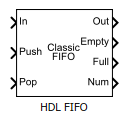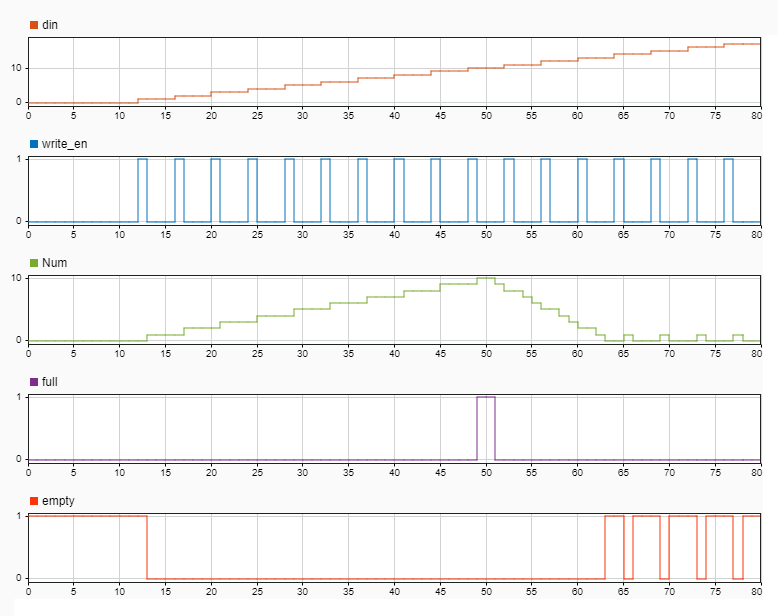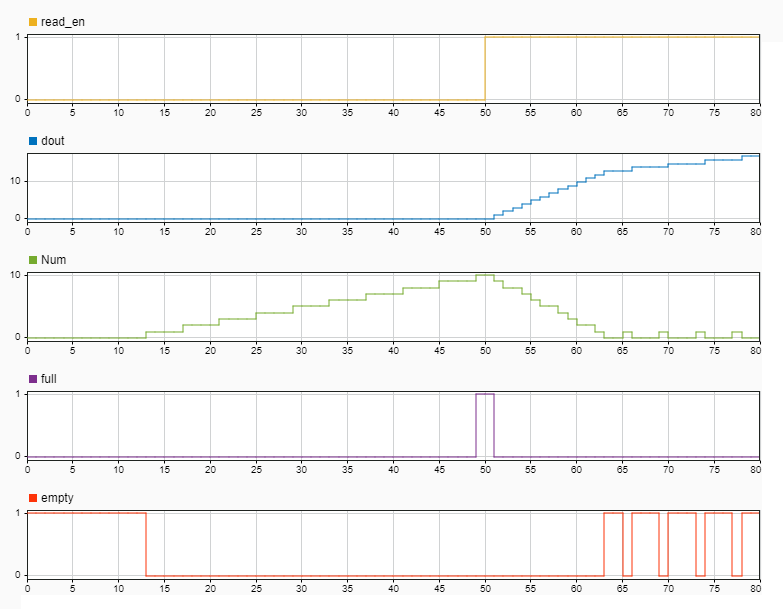HDL FIFO
Stores sequence of input samples in first in, first out (FIFO) register
- Library:
HDL Coder / HDL RAMs

Description
The HDL FIFO block stores a sequence of input samples in a first in, first out (FIFO) register. The data written first into the FIFO register comes out first. The block implementation resembles the FIFO unit in hardware platforms in terms of functionality and behavior.
Ports
Input
In — Data input signal
scalar
Data input signal to the FIFO block. When you write data into the FIFO, the newest data is pushed to the end of the FIFO register. The block pushes subsequent data entries below this entry.
Data Types: single | double | int8 | int16 | int32 | int64 | uint8 | uint16 | uint32 | uint64 | Boolean | fixed point
Push — Write control signal
scalar
When this port receives a value of 1, the block
pushes the input at the In port onto the end of the
FIFO register.
Data Types: Boolean
Pop — Read control signal
scalar
When this port receives a value of 1, the block
pops the first element off the FIFO register and holds the
Out port at that value.
Data Types: Boolean
Note
If two or more of the control input ports are triggered in the same time step, the pop operation executes first, followed by the push operation.
Output
Out — Data output signal
scalar
Data output signal from the FIFO block. When you read data from the FIFO, the data that you wrote first into the FIFO register comes off the FIFO and is held at the output.
Data Types: single | double | int8 | int16 | int32 | int64 | uint8 | uint16 | uint32 | uint64 | Boolean | fixed point
Empty — Data output signal
scalar
Control signal output from the FIFO that becomes 1
when the FIFO register is empty and does not contain data
entries.
Dependencies
To enable this port, Show empty register indicator port (Empty) must be selected.
Data Types: Boolean
Full — Data output signal
scalar
Control signal output from the FIFO that becomes 1
when the FIFO register is full and cannot take more data entries.
Dependencies
To enable this port, Show full register indicator port (Full) must be selected.
Data Types: single | double | int8 | int16 | int32 | int64 | uint8 | uint16 | uint32 | uint64 | Boolean | fixed point
Num — Number of entries
scalar
Number of data entries that are currently inside the FIFO register.
Num increments by 1 for
every data that you write into the FIFO. Num
decrements by 1 for every data that you read from the
FIFO.
Dependencies
To enable this port, Show number of entries register port (Num) must be selected.
Data Types: single | double | int8 | int16 | int32 | int64 | uint8 | uint16 | uint32 | uint64 | Boolean | fixed point
Parameters
Register size — Number of entries
10 (default)
Specify the number of entries that the FIFO register can hold. The default
value for Register size is 10. The
minimum value for Register size is
4.
Programmatic Use
Block parameter:
fifo_size |
| Type: character vector |
| Value: An integer greater than or equal to four |
Default:
'10' |
Mode — Operation mode
'Classic' (default) | 'FWFT'
Specify the operation mode of the FIFO. By default, the
Mode is set to Classic. You see
that the block icon displays Classic FIFO. You can change
the Mode to FWFT. When you change
the Mode, the block icon displays FWFT
FIFO. By using the FWFT mode, you can
lookahead and see the first word written to the FIFO register without
placing a read request. The FWFT mode is especially useful when you apply
the back-pressure with AXI4-Stream interfaces.
Programmatic Use
Block parameter:
mode |
| Type: character vector |
Value:
'Classic' | 'FWFT' | |
Default:
'Classic' |
The ratio of output sample time to input sample time — Sample rate ratio
1 (default)
Specify the ratio of output sample time to input sample time. The default
ratio is 1, which means that the inputs
In and Push, and outputs
Out and Pop, run at the same
sample rate. The inputs and outputs can run at different sample times. Use a
positive integer or 1/N, where N is a
positive integer. For example, if you enter 1/2, the
output sample time is half the input sample time, or the outputs run faster.
The Full, Empty, and
Num signals run at the faster rate.
Programmatic Use
Block parameter:
ratio |
| Type: character vector |
| Value: An integer greater than or equal to one |
Default:
'1' |
Push onto full register — Overflow condition
'Warning' (default) | 'Ignore' | 'Error'
Specify how you want the block to respond when you write to a FIFO that is
full. The default is Warning.
Programmatic Use
Block parameter:
push_msg |
| Type: character vector |
Value:
'Warning' | 'Ignore' |
'Error' |
Default:
'Warning' |
Pop onto empty register — Underflow condition
'Warning' (default) | 'Ignore' | 'Error'
Specify how you want the block to respond when you read from a FIFO that
is empty. The default is Warning.
Programmatic Use
Block parameter:
pop_msg |
| Type: character vector |
Value:
'Warning' | 'Ignore' |
'Error' |
Default:
'Warning' |
Show empty register indicator port (Empty) — Optional empty port
on (default) | off
Specify whether to enable the Empty output port. This
port outputs a 1 when the FIFO register is empty and
0 when the FIFO contains one or more data
entries.
Programmatic Use
Block parameter:
show_empty |
| Type: character vector |
Value:
'on' | 'off' |
Default:
'on' |
Show full register indicator port (Full) — Optional full port
on (default) | off
Specify whether to enable the Full output port. This
port outputs a 1 when the FIFO register is full.
Programmatic Use
Block parameter:
show_full |
| Type: character vector |
Value:
'on' | 'off' |
Default:
'on' |
Show num register indicator port (Num) — Optional num port
on (default) | off
Specify whether to enable the Num output port. This
port outputs the number of data entries that are currently available in the
FIFO queue.
Programmatic Use
Block parameter:
show_num |
| Type: character vector |
Value:
'on' | 'off' |
Default:
'on' |
Algorithms
FIFO Write Operation
This figure displays the FIFO write operation. The Push input port acts as the enable signal for the write operation. This signal is denoted by the write_en signal in the figure.

When the write_en signal is 0, the block
does not write data to the FIFO and the empty flag is
asserted.
When the write_en becomes 1, the block
pushes the din signal at input port In to
the end of the FIFO register in the next time step. The Num
signal indicates the number of data entries in the FIFO register. Every time you
write data into the FIFO, the Num signal increments by
1. At time step 12,
write_en is 1. At the next time step
13, data is written to the FIFO. Num
signal increments by 1 and the empty flag is
de-asserted.
This FIFO uses the default register size of 10. When the
Num signal becomes equal to the Register
size at time step 49, the
Full signal is asserted. After the
Full signal becomes 1, if you try to
write more entries into the FIFO, the block generates a warning.
Classic FIFO Read Operation
This figure displays the FIFO read operation. The Pop input port acts as the enable signal for the read operation. This signal is denoted by the read_en signal in the figure.

When the read_en signal is 0, the block
output dout is 0. When the
read_en signal becomes 1 at time step
50, the dout signal outputs the oldest
entry in the FIFO in the next time step 51. The
Full flag is de-asserted and the Num
signal decrements by 1 starting from time step
51 as you read data from the FIFO.
When the Num signal becomes equal to 0,
the Empty signal is asserted. After the
Empty signal becomes 0, if you try to
read more entries from the FIFO, the block generates a warning.
FWFT FIFO Read Operation
This figure displays the FIFO read operation. The Pop input port acts as the enable signal for the read operation. This signal is denoted by the read_en signal in the figure.

By default, the HDL FIFO works in the Classic
mode. You can also use a first-word-fall-through (FWFT) mode for the FIFO. In the
Block Parameters dialog box, specify the Mode as
FWFT.
In the FWFT mode, the write operation works in the same way as
the Classic mode. The FWFT mode differs from
the Classic mode when you perform a read operation. In the
Classic mode, after you place a read request or input a
1 to the Pop port, the data becomes
available at the FIFO output in the next clock cycle. In the FWFT
mode, the first word you write to the FIFO falls through to the output and is
available at the output signal Out.
In the figure, though read-en becomes 1 at
time step 50, the FIFO read the first word
dout at time step 15. You can use this
capability to look ahead and see the first word that has been written to the
FIFO.
Extended Capabilities
HDL Code Generation
Generate Verilog and VHDL code for FPGA and ASIC designs using HDL Coder™.
HDL Coder™ provides additional configuration options that affect HDL implementation and synthesized logic.
HDL Architecture
This block has a single, default HDL architecture.
HDL Block Properties
| General | |
|---|---|
| ConstrainedOutputPipeline | Number of registers to place at
the outputs by moving existing delays within your design. Distributed
pipelining does not redistribute these registers. The default is
|
| InputPipeline | Number of input pipeline stages
to insert in the generated code. Distributed pipelining and constrained
output pipelining can move these registers. The default is
|
| OutputPipeline | Number of output pipeline stages
to insert in the generated code. Distributed pipelining and constrained
output pipelining can move these registers. The default is
|